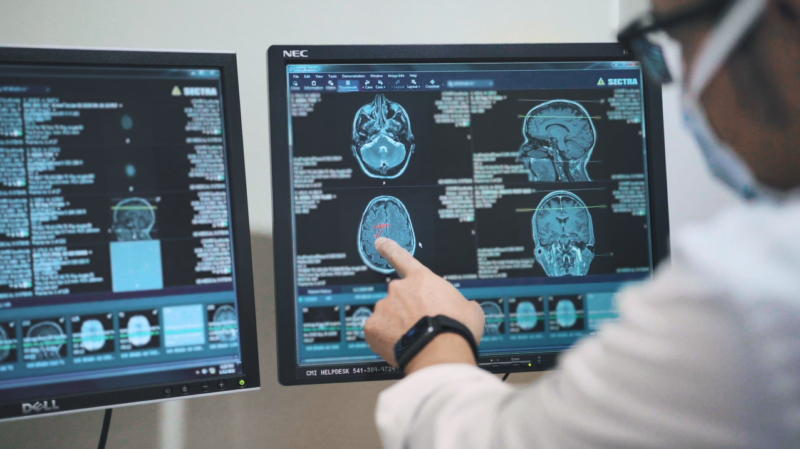
What is a brain aneurysm?
A brain aneurysm is a bulge that forms in the wall of a weakened artery in the brain. If an aneurysm ruptures, blood spills into the space between the skull and the brain, causing a serious type of stroke known as a subarachnoid hemorrhage (SAH). Thinning of the arterial wall can occur gradually over time, and aneurysms most commonly develop at the base of arterial branches of the brain as the arteries are their weakest at these points. A ruptured aneurysm requires prompt medical treatment as it can quickly become life-threatening. However, not all brain aneurysms rupture and in some cases may be treated to prevent any rupturing in the future. These are often detected during tests for other conditions. Speak with your doctor to determine the best treatment plan for your specific needs.
Facts about aneurysms
Aneurysms vary in size. A small aneurysm is between 1/8 inch to almost 1 inch. It’s estimated that 50-80% of small aneurysms will not rupture. An aneurysm that is greater than 1 inch is considered a “giant” aneurysm, which is at a much higher risk of rupturing and can be difficult to treat.
• An estimated 6.5 million people in the United States have an unruptured brain aneurysm, or 1 in 50 people.
• Women are more likely than men to have a brain aneurysm (3:2 ratio).
• Brain aneurysms are most prevalent in people ages 35 to 60, but can occur in children as well. Most aneurysms develop after the age of 40.
• Women, particularly those over the age of 55, have a higher risk of brain aneurysm rupture than men (about 1.5 times the risk).
What symptoms should you look out for?
Brain aneurysms that have not ruptured typically have little to no symptoms. These aneurysms are most often smaller in size, and most are found incidentally when tests are being done to screen for other conditions.
If a small aneurysm grows larger and begins to press on nerves in the brain, such symptoms may be experienced.
- Blurred or double vision
- A drooping eyelid
- A dilated pupil
- Pain above and behind one eye
- Weakness and/or numbness
If you experience these symptoms, seek immediate medical attention.

Ruptured brain aneurysms are much more dangerous and not all of the symptoms listed below may be present at once. When an aneurysm ruptures, bleeding in the space around the brain usually occurs causing sudden symptoms. These sudden symptoms may include the following.
• Sudden and severe headache, often described as “the worst headache of my life”
• Nausea/vomiting
• Stiff neck
• Blurred or double vision
• Sensitivity to light
• Seizure
• Drooping eyelid
• A dilated pupil
• Pain above and behind the eye
• Loss of consciousness
• Confusion
• Weakness and/or numbness
If you experience any of the above symptoms of a ruptured aneurysm, call 911.
Causes and Risk Factors
Although the causes of a brain aneurysm are unknown, many other factors may increase your risk. Brain aneurysms are more common in female adults. Other common risk factors include:
- Drug abuse
- Hypertension
- Older Age
- Cigarette smoking
- Excessive alcohol consumption
- Head trauma from an injury
Complications
When a brain aneurysm ruptures, the pressure inside of the skull increases and the bleeding can cause irritation to the lining of the brain, damaging cells. When your skull experiences that amount of pressure, the blood and oxygen levels to your brain are disrupted causing loss of consciousness or even death.
Other complications that can develop after a brain aneurysm rupture include:
- Subarachnoid hemorrhage (SAH): A life-threatening type of stroke caused by bleeding in the brain.
- Hydrocephalus: Confusion, lethargy, and loss of consciousness caused by increased pressure in the skull that forces the brain to shift and herniate.
- Vasospasm: This occurs 5-10 days after the rupture when the walls of the artery begin to spasm and narrow, reducing blood flow to the part of the brain, causing a secondary stroke.





